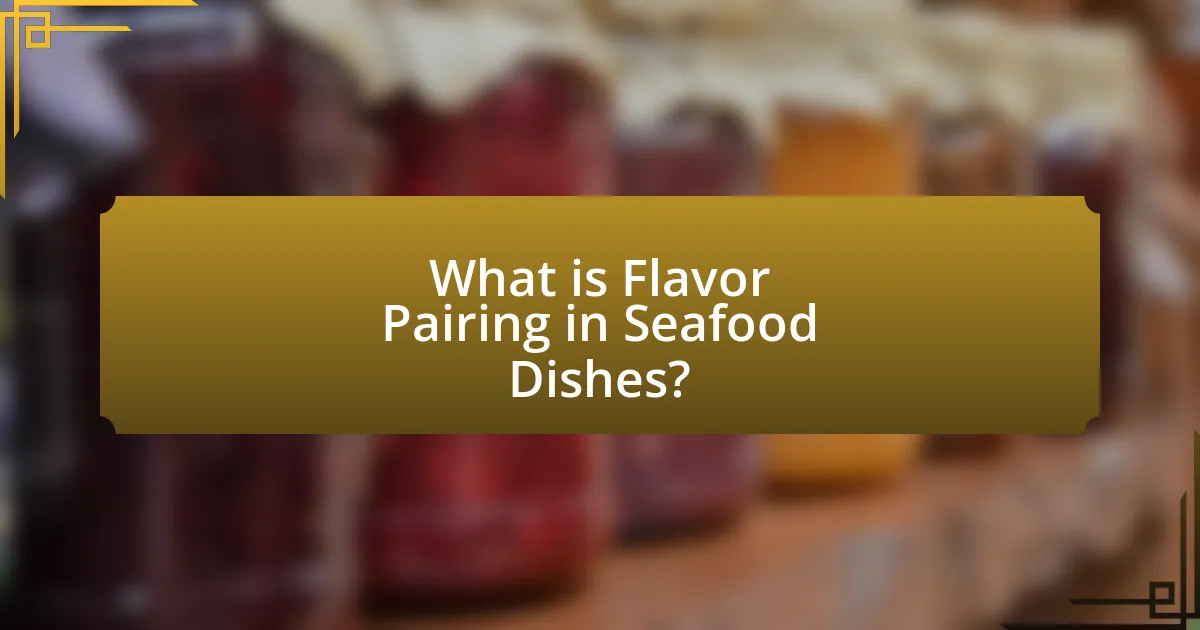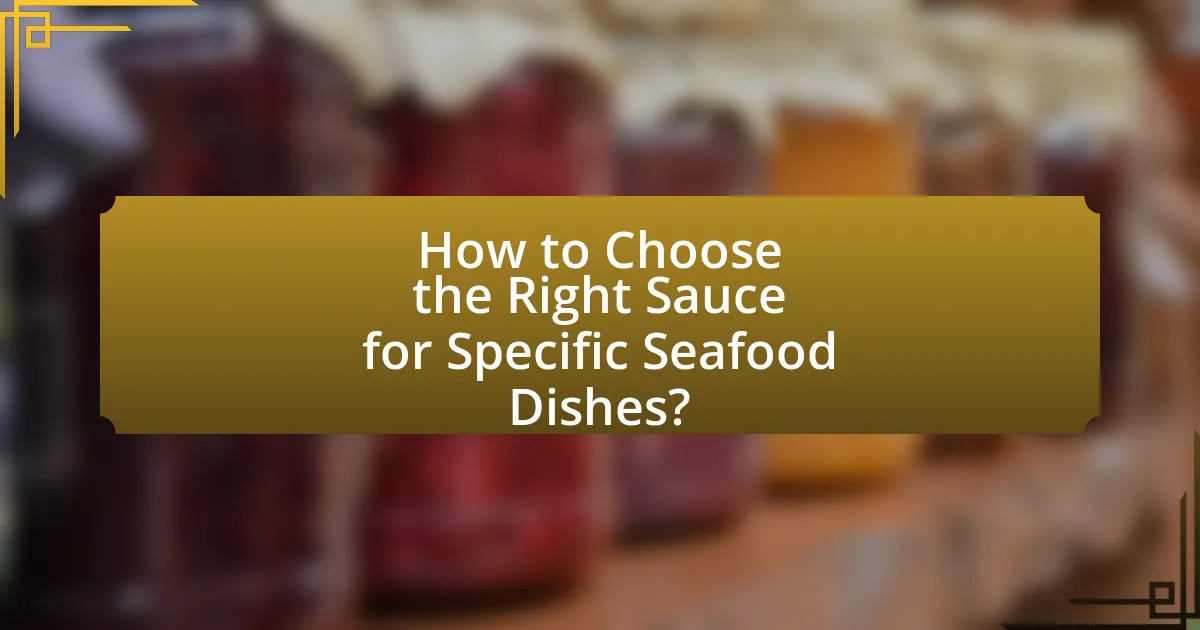The article focuses on the essential practice of flavor pairing in seafood dishes, emphasizing how complementary ingredients enhance the overall taste experience. It explores the principles of flavor pairing, the interaction of different flavor profiles with seafood, and the significance of sauce selection in elevating seafood dishes. Key topics include the types of sauces that pair well with various seafood, the influence of regional cuisines on sauce choices, and practical tips for creating balanced sauces that highlight the natural flavors of seafood. The article provides insights into how to effectively match sauces with seafood to achieve a harmonious dining experience.

What is Flavor Pairing in Seafood Dishes?
Flavor pairing in seafood dishes refers to the practice of combining seafood with complementary flavors to enhance the overall taste experience. This technique relies on understanding which ingredients, such as herbs, spices, and sauces, harmonize with the natural flavors of various seafood types. For example, citrus elements like lemon or lime often pair well with fish due to their ability to cut through the richness and add brightness. Research indicates that certain flavor compounds in seafood, such as amino acids and fatty acids, interact positively with specific herbs and spices, creating a balanced and appealing dish.
How does flavor pairing enhance seafood dishes?
Flavor pairing enhances seafood dishes by creating complementary taste profiles that elevate the overall dining experience. When specific flavors are matched with seafood, such as citrus with fish or garlic with shellfish, they can enhance the natural sweetness and umami of the seafood. Research indicates that flavor compounds in ingredients like herbs, spices, and sauces can interact with the seafood’s inherent flavors, resulting in a more balanced and enjoyable dish. For example, the acidity in lemon or lime can brighten the flavors of fatty fish, while the richness of butter can complement the delicate texture of shellfish, making the dish more appealing and satisfying.
What are the basic principles of flavor pairing?
The basic principles of flavor pairing involve combining ingredients that share similar flavor compounds or sensory characteristics. This concept is grounded in the idea that flavors can enhance each other when they have complementary profiles, such as sweet and salty or acidic and fatty. Research by food scientists, including the work of chef Heston Blumenthal, demonstrates that ingredients with shared aromatic compounds, like basil and strawberries, create harmonious pairings. Additionally, contrasting flavors can also work well together, as seen in the balance of rich sauces with light seafood dishes, enhancing the overall taste experience.
How do different flavor profiles interact with seafood?
Different flavor profiles interact with seafood by enhancing or complementing its natural taste, which is often delicate and subtle. For instance, citrus flavors, such as lemon or lime, brighten seafood dishes by cutting through the richness of fatty fish like salmon, while herbs like dill or parsley add freshness that elevates the overall flavor. Additionally, umami-rich ingredients, such as soy sauce or miso, deepen the flavor experience, particularly with shellfish. A study published in the Journal of Culinary Science & Technology highlights that pairing seafood with contrasting flavors, such as sweet and spicy sauces, can create a balanced dish that appeals to a wide range of palates.
Why is sauce selection important for seafood?
Sauce selection is important for seafood because it enhances the natural flavors and textures of the dish. Seafood often has delicate flavors that can be complemented or overwhelmed by the choice of sauce. For instance, a light lemon butter sauce can elevate the taste of grilled fish without masking its inherent qualities, while a heavy cream sauce may overpower it. Studies have shown that flavor pairing, such as using citrus or herbs with seafood, can significantly improve the overall dining experience by creating a harmonious balance.
What role do sauces play in enhancing seafood flavors?
Sauces play a crucial role in enhancing seafood flavors by adding complementary tastes, textures, and aromas that elevate the overall dining experience. For instance, acidic sauces like lemon butter or vinaigrettes can brighten the natural flavors of fish, while creamy sauces can provide richness that balances the delicate nature of seafood. Additionally, sauces infused with herbs and spices can introduce new flavor dimensions, making the dish more complex and appealing. Research indicates that the right sauce can increase the perception of freshness and quality in seafood, thereby improving consumer satisfaction.
How can the right sauce complement various seafood types?
The right sauce can enhance the flavors of various seafood types by providing complementary tastes and textures. For instance, a citrus-based sauce, such as a lemon butter sauce, can brighten the natural sweetness of shrimp, while a rich, creamy sauce can balance the delicate flavors of scallops. Additionally, a spicy aioli can add depth to fried fish, creating a contrast that elevates the dish. Studies show that flavor pairing, such as using herbs and spices that match the seafood’s profile, can significantly improve the overall dining experience, making the dish more enjoyable and memorable.

What Types of Sauces Pair Well with Seafood?
Citrus-based sauces, such as lemon butter and orange beurre blanc, pair well with seafood due to their ability to enhance the natural flavors of fish and shellfish. These sauces provide acidity that balances the richness of seafood, making them a popular choice in culinary practices. Additionally, herb-infused sauces like chimichurri and pesto complement seafood by adding freshness and complexity, while creamy sauces, such as tartar sauce and aioli, offer a rich contrast that works well with fried or grilled seafood. The effectiveness of these pairings is supported by culinary traditions that emphasize the balance of flavors, ensuring that the sauce enhances rather than overwhelms the seafood.
What are the most common sauces used with seafood?
The most common sauces used with seafood include tartar sauce, cocktail sauce, garlic butter, and lemon butter sauce. Tartar sauce, made from mayonnaise, pickles, and capers, complements fried fish dishes. Cocktail sauce, typically a blend of ketchup and horseradish, is a classic pairing for shrimp and crab. Garlic butter, which combines melted butter with minced garlic, enhances the flavor of grilled or sautéed seafood. Lemon butter sauce, made from butter and fresh lemon juice, adds brightness to various seafood preparations. These sauces are widely recognized for their ability to enhance the natural flavors of seafood dishes.
How do creamy sauces affect the taste of seafood?
Creamy sauces enhance the taste of seafood by adding richness and depth, which complements the natural flavors of the seafood. The fat content in creamy sauces, often derived from ingredients like cream or butter, creates a smooth mouthfeel that balances the often delicate and subtle flavors of seafood. For example, a classic pairing is lobster with a creamy butter sauce, where the sauce amplifies the sweetness of the lobster while providing a luxurious texture. Additionally, creamy sauces can incorporate herbs and spices, further elevating the overall flavor profile and creating a harmonious blend with the seafood.
What are the benefits of using citrus-based sauces?
Citrus-based sauces enhance seafood dishes by providing acidity, which balances flavors and cuts through richness. The acidity from citrus fruits like lemon and lime brightens the overall taste, making seafood more palatable. Additionally, citrus-based sauces often contain essential vitamins, such as vitamin C, which supports immune function and overall health. The combination of acidity and freshness in these sauces can also elevate the sensory experience of seafood, making it more appealing to consumers.
How do regional cuisines influence sauce choices for seafood?
Regional cuisines significantly influence sauce choices for seafood by incorporating local ingredients, flavors, and culinary traditions. For example, Mediterranean cuisines often use olive oil, lemon, and herbs like parsley, reflecting the region’s agricultural products and climate. In contrast, Asian cuisines may favor soy sauce, ginger, and sesame, highlighting the use of fermented products and spices prevalent in those cultures. This regional specificity is supported by the fact that traditional recipes evolve based on available resources and historical trade routes, which shape local palates and preferences. Thus, the choice of sauces for seafood is deeply rooted in the cultural and environmental context of each region.
What are some traditional sauces from coastal regions?
Traditional sauces from coastal regions include aioli, tartar sauce, and chimichurri. Aioli, originating from the Mediterranean, is a garlic and olive oil emulsion often served with seafood. Tartar sauce, commonly associated with fish and chips, combines mayonnaise, pickles, and capers, enhancing the flavor of fried fish. Chimichurri, a vibrant sauce from Argentina, features parsley, garlic, vinegar, and oil, complementing grilled seafood dishes. These sauces are integral to coastal cuisine, enhancing the natural flavors of seafood.
How do cultural flavors shape seafood sauce pairings?
Cultural flavors significantly shape seafood sauce pairings by influencing the choice of ingredients and preparation methods that complement specific seafood types. For instance, in Mediterranean cuisine, sauces often incorporate olive oil, garlic, and herbs, enhancing the natural flavors of fish like sardines and anchovies. In contrast, Asian culinary traditions may favor soy sauce, ginger, and sesame, which pair well with seafood such as shrimp and scallops, creating a balance of umami and sweetness. Historical trade routes and local ingredients further dictate these flavor profiles, as seen in the use of chili and lime in Latin American seafood dishes, which provide a zesty contrast to the richness of fish. Thus, cultural contexts not only dictate the flavors used but also the overall dining experience associated with seafood.

How to Choose the Right Sauce for Specific Seafood Dishes?
To choose the right sauce for specific seafood dishes, consider the flavor profile of both the seafood and the sauce. For example, light sauces like lemon butter or herb vinaigrettes complement delicate fish such as sole or flounder, enhancing their subtle flavors without overpowering them. In contrast, richer sauces like creamy garlic or tomato-based sauces pair well with heartier seafood like salmon or tuna, as they can stand up to the stronger flavors of these fish. Additionally, regional sauces, such as a spicy remoulade for fried shrimp or a tangy chimichurri for grilled fish, can enhance the overall dining experience by adding cultural context and depth to the dish.
What factors should be considered when pairing sauces with seafood?
When pairing sauces with seafood, consider the flavor profile, texture, and cooking method of the seafood. The flavor profile should complement the natural taste of the seafood; for instance, light sauces like lemon butter enhance delicate fish, while richer sauces like cream-based ones suit heartier varieties. Texture is important as well; a smooth sauce can balance the flakiness of fish, while a chunky sauce can add interest to firmer seafood. Additionally, the cooking method influences sauce choice; grilled seafood pairs well with tangy sauces, while poached seafood benefits from lighter, more subtle sauces. These considerations ensure a harmonious balance between the seafood and the sauce, enhancing the overall dining experience.
How does the cooking method affect sauce selection?
The cooking method significantly influences sauce selection by determining the flavor profile and texture of the dish. For instance, grilling seafood often enhances its natural flavors, making lighter sauces like citrus vinaigrettes or herb-infused oils more suitable, as they complement rather than overpower the grilled taste. Conversely, poaching seafood retains moisture and tenderness, allowing for richer sauces, such as creamy or buttery sauces, to enhance the dish without overwhelming it. This relationship between cooking methods and sauce selection is supported by culinary principles that emphasize balance and harmony in flavor profiles, ensuring that the sauce enhances the overall dish rather than detracts from it.
What seafood flavors should be highlighted with sauces?
Seafood flavors that should be highlighted with sauces include the natural sweetness of shellfish, the brininess of fish, and the delicate taste of white fish. For instance, a citrus-based sauce enhances the sweetness of shrimp and scallops, while a garlic butter sauce complements the briny flavor of oysters and clams. Additionally, a light herb sauce can elevate the subtle flavors of white fish like cod or sole, allowing their natural taste to shine through. These pairings are supported by culinary practices that emphasize balancing and enhancing the inherent flavors of seafood.
How can you experiment with sauce pairings for seafood?
To experiment with sauce pairings for seafood, start by selecting a variety of sauces that complement the natural flavors of different seafood types. For instance, citrus-based sauces like lemon butter or orange salsa enhance the freshness of white fish, while richer sauces such as garlic cream or tomato-based sauces pair well with heartier seafood like salmon or tuna.
Additionally, consider the flavor profiles of the seafood; for example, sweet sauces like teriyaki can balance the saltiness of grilled shrimp. Experimentation can also involve adjusting the acidity, sweetness, and spice levels in sauces to find the perfect match.
Taste testing is crucial; try small portions of seafood with different sauces to determine which combinations work best. This method allows for a personalized approach to flavor pairing, ensuring that the sauce enhances rather than overwhelms the seafood.
What are some creative sauce combinations for popular seafood dishes?
Creative sauce combinations for popular seafood dishes include mango salsa with grilled shrimp, which adds a sweet and tangy flavor profile. Another combination is lemon butter sauce paired with crab, enhancing the natural sweetness of the meat. For fish tacos, a chipotle aioli provides a smoky kick that complements the fish. Additionally, a ginger-soy glaze works well with salmon, offering a savory and slightly sweet taste that elevates the dish. These combinations are effective because they balance the seafood’s flavors while introducing complementary elements, enhancing the overall dining experience.
How can you balance flavors when creating your own sauces?
To balance flavors when creating your own sauces, start by identifying the primary flavor profiles: sweet, salty, sour, bitter, and umami. Each of these profiles can be adjusted to achieve harmony. For instance, if a sauce is too acidic, adding a sweet element like honey can counterbalance the sourness. Similarly, if a sauce is overly salty, incorporating a sour component, such as vinegar, can help to mitigate the saltiness.
Research indicates that the balance of these flavors is crucial in culinary practices; for example, a study published in the “Journal of Culinary Science & Technology” highlights that sauces with a well-rounded flavor profile enhance the overall dining experience. By systematically adjusting these elements, you can create a sauce that complements seafood dishes effectively, ensuring that no single flavor overwhelms the others.
What are some practical tips for pairing sauces with seafood dishes?
To effectively pair sauces with seafood dishes, consider the flavor profiles of both the seafood and the sauce. Light, delicate seafood like sole or flounder pairs well with lighter sauces such as lemon butter or herb vinaigrettes, enhancing the natural flavors without overpowering them. Conversely, richer seafood like salmon or tuna can handle bolder sauces, such as teriyaki or spicy aioli, which complement their robust taste.
Additionally, acidity plays a crucial role; citrus-based sauces can brighten the dish, while creamy sauces can add richness. For example, a creamy dill sauce works well with grilled fish, balancing the flavors. Finally, regional pairings can also guide choices; for instance, a tomato-based sauce is often used with Mediterranean seafood dishes, reflecting traditional culinary practices.

Leave a Reply